Finance and Funding in Travel and Tourism: Financial Factors Report
VerifiedAdded on 2020/10/22
|11
|3059
|314
Report
AI Summary
This report delves into the financial aspects of the travel and tourism sector, focusing on a case study of a wildlife trust. It examines the importance of costs, volume, and profits in management decision-making, exploring different cost types (direct, indirect, fixed, and variable) and their impact on profitability. The report also analyzes pricing methods such as skimming and per-person pricing, along with factors influencing profits like tourist seasons, climate, and political considerations. Furthermore, it explores the uses of management accounting information, including financial management, variance analysis, budgeting, and forecasting. The report then interprets financial statements using ratio analysis, focusing on liquidity, profitability, and efficiency ratios, and concludes with an analysis of funding sources for public and non-public tourism development.
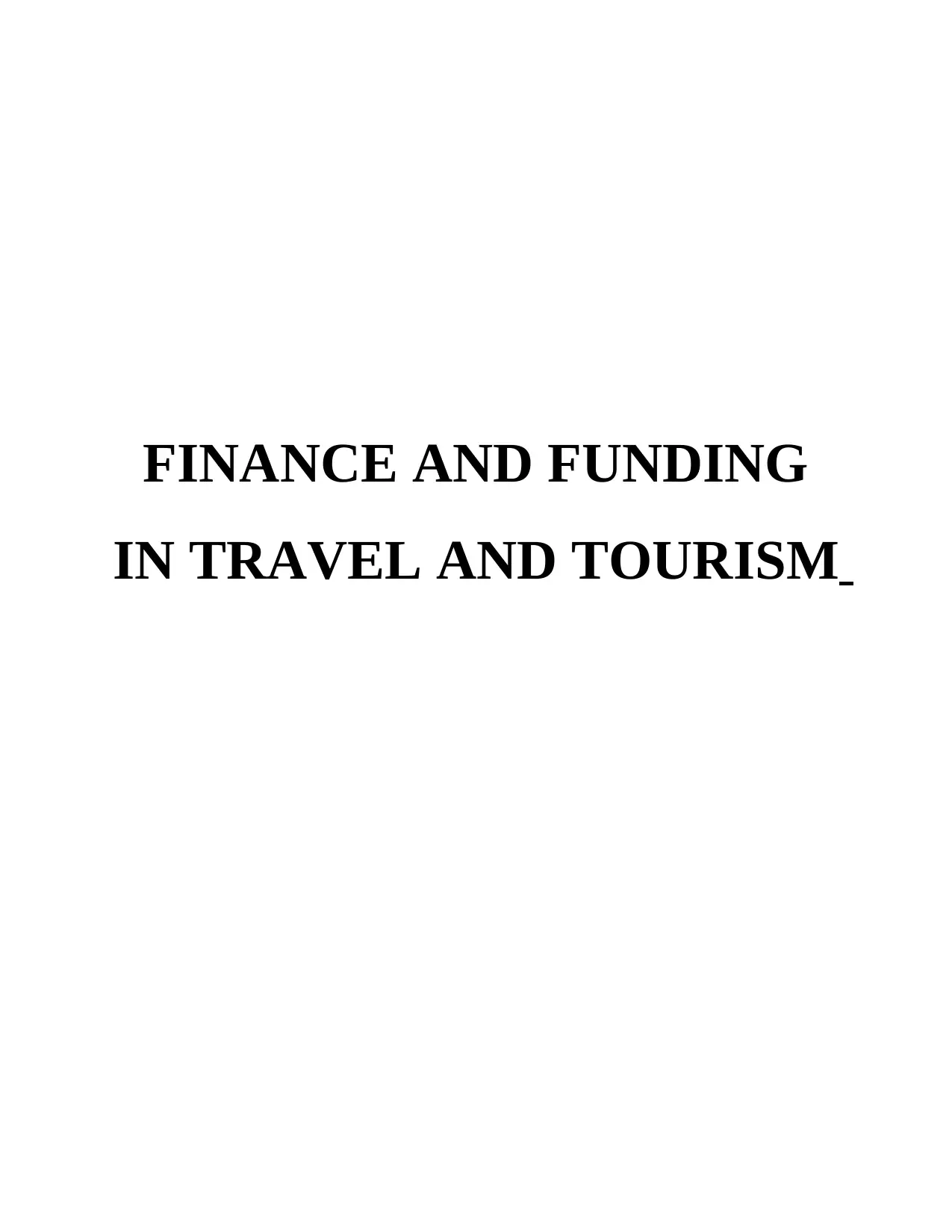
FINANCE AND FUNDING
IN TRAVEL AND TOURISM
IN TRAVEL AND TOURISM
Paraphrase This Document
Need a fresh take? Get an instant paraphrase of this document with our AI Paraphraser
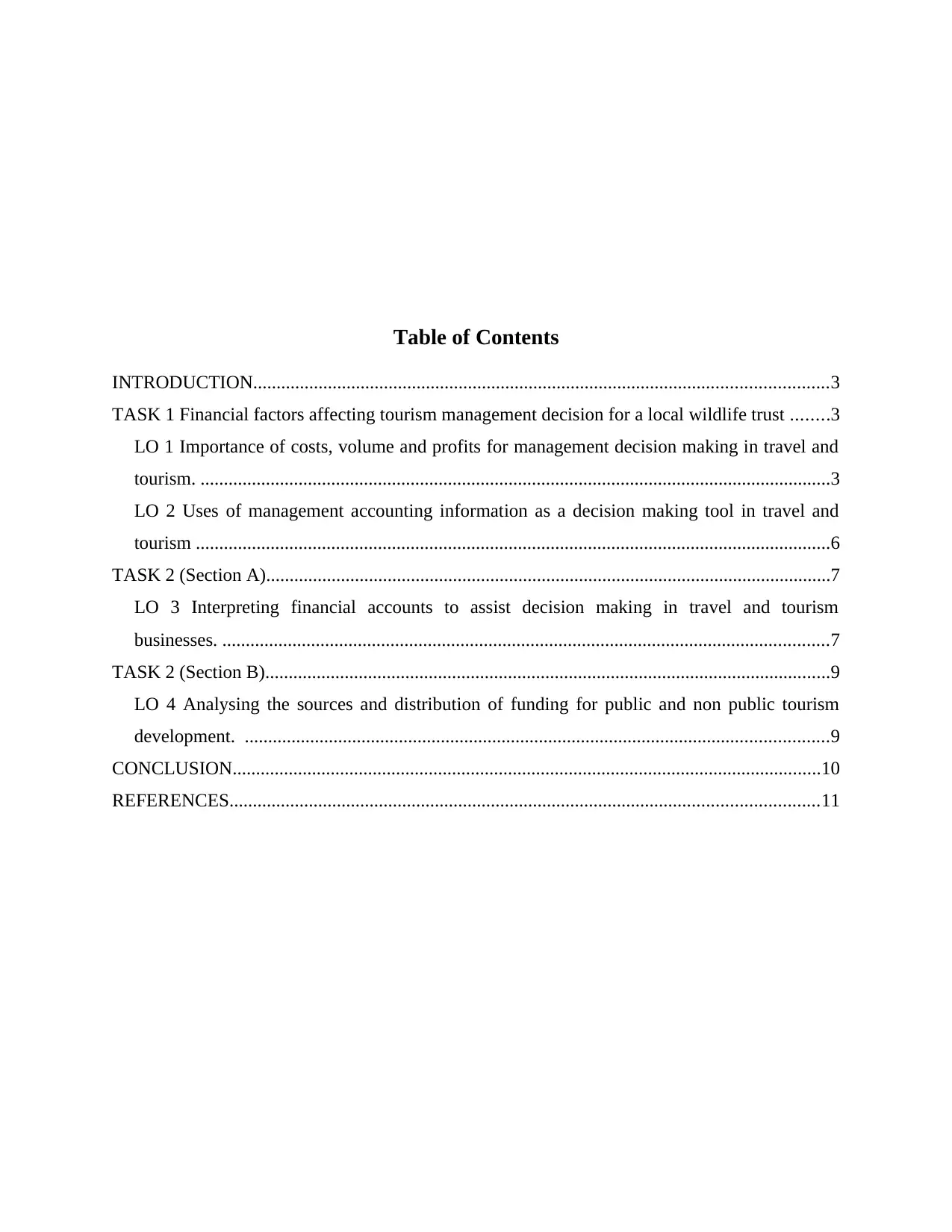
Table of Contents
INTRODUCTION...........................................................................................................................3
TASK 1 Financial factors affecting tourism management decision for a local wildlife trust ........3
LO 1 Importance of costs, volume and profits for management decision making in travel and
tourism. .......................................................................................................................................3
LO 2 Uses of management accounting information as a decision making tool in travel and
tourism ........................................................................................................................................6
TASK 2 (Section A).........................................................................................................................7
LO 3 Interpreting financial accounts to assist decision making in travel and tourism
businesses. ..................................................................................................................................7
TASK 2 (Section B).........................................................................................................................9
LO 4 Analysing the sources and distribution of funding for public and non public tourism
development. .............................................................................................................................9
CONCLUSION..............................................................................................................................10
REFERENCES..............................................................................................................................11
INTRODUCTION...........................................................................................................................3
TASK 1 Financial factors affecting tourism management decision for a local wildlife trust ........3
LO 1 Importance of costs, volume and profits for management decision making in travel and
tourism. .......................................................................................................................................3
LO 2 Uses of management accounting information as a decision making tool in travel and
tourism ........................................................................................................................................6
TASK 2 (Section A).........................................................................................................................7
LO 3 Interpreting financial accounts to assist decision making in travel and tourism
businesses. ..................................................................................................................................7
TASK 2 (Section B).........................................................................................................................9
LO 4 Analysing the sources and distribution of funding for public and non public tourism
development. .............................................................................................................................9
CONCLUSION..............................................................................................................................10
REFERENCES..............................................................................................................................11
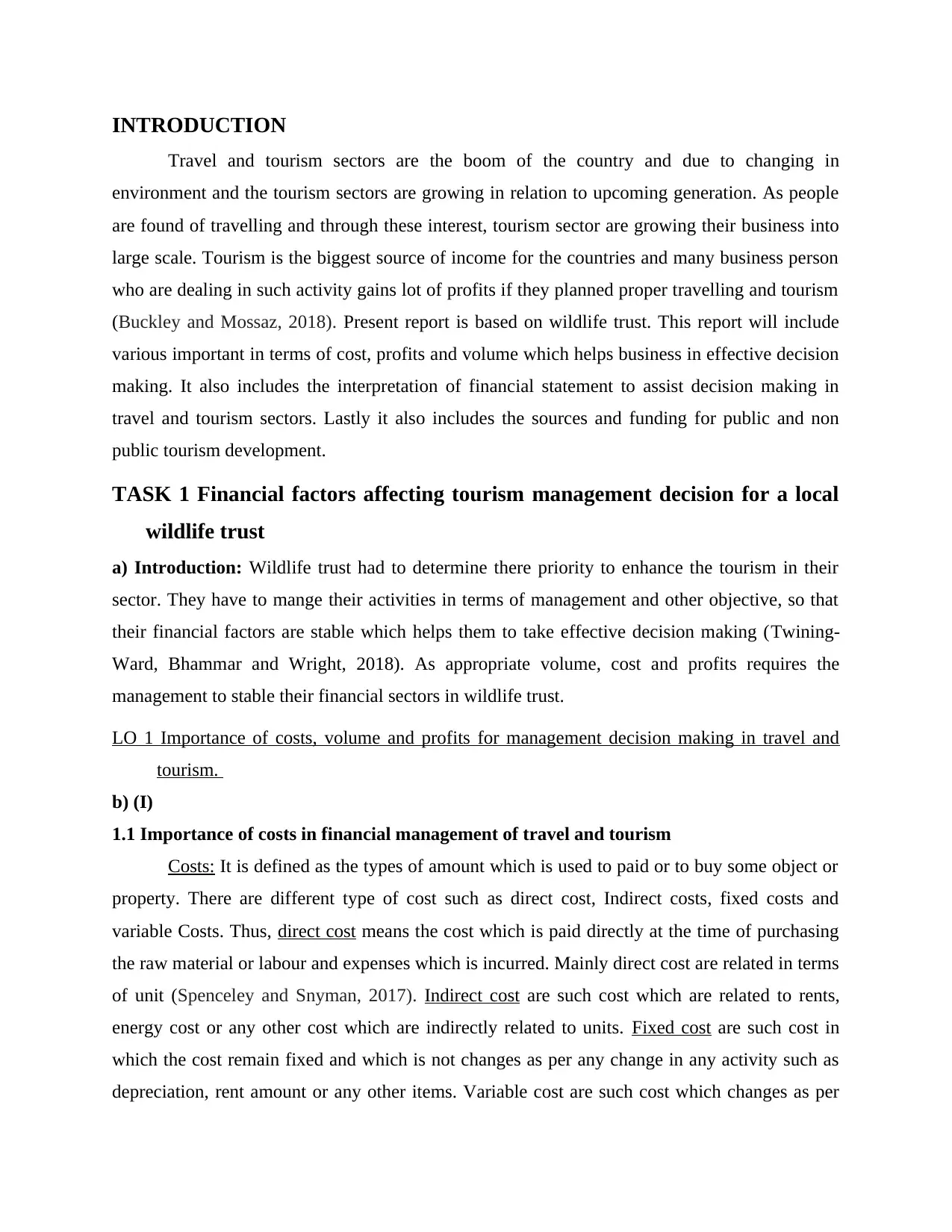
INTRODUCTION
Travel and tourism sectors are the boom of the country and due to changing in
environment and the tourism sectors are growing in relation to upcoming generation. As people
are found of travelling and through these interest, tourism sector are growing their business into
large scale. Tourism is the biggest source of income for the countries and many business person
who are dealing in such activity gains lot of profits if they planned proper travelling and tourism
(Buckley and Mossaz, 2018). Present report is based on wildlife trust. This report will include
various important in terms of cost, profits and volume which helps business in effective decision
making. It also includes the interpretation of financial statement to assist decision making in
travel and tourism sectors. Lastly it also includes the sources and funding for public and non
public tourism development.
TASK 1 Financial factors affecting tourism management decision for a local
wildlife trust
a) Introduction: Wildlife trust had to determine there priority to enhance the tourism in their
sector. They have to mange their activities in terms of management and other objective, so that
their financial factors are stable which helps them to take effective decision making (Twining-
Ward, Bhammar and Wright, 2018). As appropriate volume, cost and profits requires the
management to stable their financial sectors in wildlife trust.
LO 1 Importance of costs, volume and profits for management decision making in travel and
tourism.
b) (I)
1.1 Importance of costs in financial management of travel and tourism
Costs: It is defined as the types of amount which is used to paid or to buy some object or
property. There are different type of cost such as direct cost, Indirect costs, fixed costs and
variable Costs. Thus, direct cost means the cost which is paid directly at the time of purchasing
the raw material or labour and expenses which is incurred. Mainly direct cost are related in terms
of unit (Spenceley and Snyman, 2017). Indirect cost are such cost which are related to rents,
energy cost or any other cost which are indirectly related to units. Fixed cost are such cost in
which the cost remain fixed and which is not changes as per any change in any activity such as
depreciation, rent amount or any other items. Variable cost are such cost which changes as per
Travel and tourism sectors are the boom of the country and due to changing in
environment and the tourism sectors are growing in relation to upcoming generation. As people
are found of travelling and through these interest, tourism sector are growing their business into
large scale. Tourism is the biggest source of income for the countries and many business person
who are dealing in such activity gains lot of profits if they planned proper travelling and tourism
(Buckley and Mossaz, 2018). Present report is based on wildlife trust. This report will include
various important in terms of cost, profits and volume which helps business in effective decision
making. It also includes the interpretation of financial statement to assist decision making in
travel and tourism sectors. Lastly it also includes the sources and funding for public and non
public tourism development.
TASK 1 Financial factors affecting tourism management decision for a local
wildlife trust
a) Introduction: Wildlife trust had to determine there priority to enhance the tourism in their
sector. They have to mange their activities in terms of management and other objective, so that
their financial factors are stable which helps them to take effective decision making (Twining-
Ward, Bhammar and Wright, 2018). As appropriate volume, cost and profits requires the
management to stable their financial sectors in wildlife trust.
LO 1 Importance of costs, volume and profits for management decision making in travel and
tourism.
b) (I)
1.1 Importance of costs in financial management of travel and tourism
Costs: It is defined as the types of amount which is used to paid or to buy some object or
property. There are different type of cost such as direct cost, Indirect costs, fixed costs and
variable Costs. Thus, direct cost means the cost which is paid directly at the time of purchasing
the raw material or labour and expenses which is incurred. Mainly direct cost are related in terms
of unit (Spenceley and Snyman, 2017). Indirect cost are such cost which are related to rents,
energy cost or any other cost which are indirectly related to units. Fixed cost are such cost in
which the cost remain fixed and which is not changes as per any change in any activity such as
depreciation, rent amount or any other items. Variable cost are such cost which changes as per
⊘ This is a preview!⊘
Do you want full access?
Subscribe today to unlock all pages.

Trusted by 1+ million students worldwide
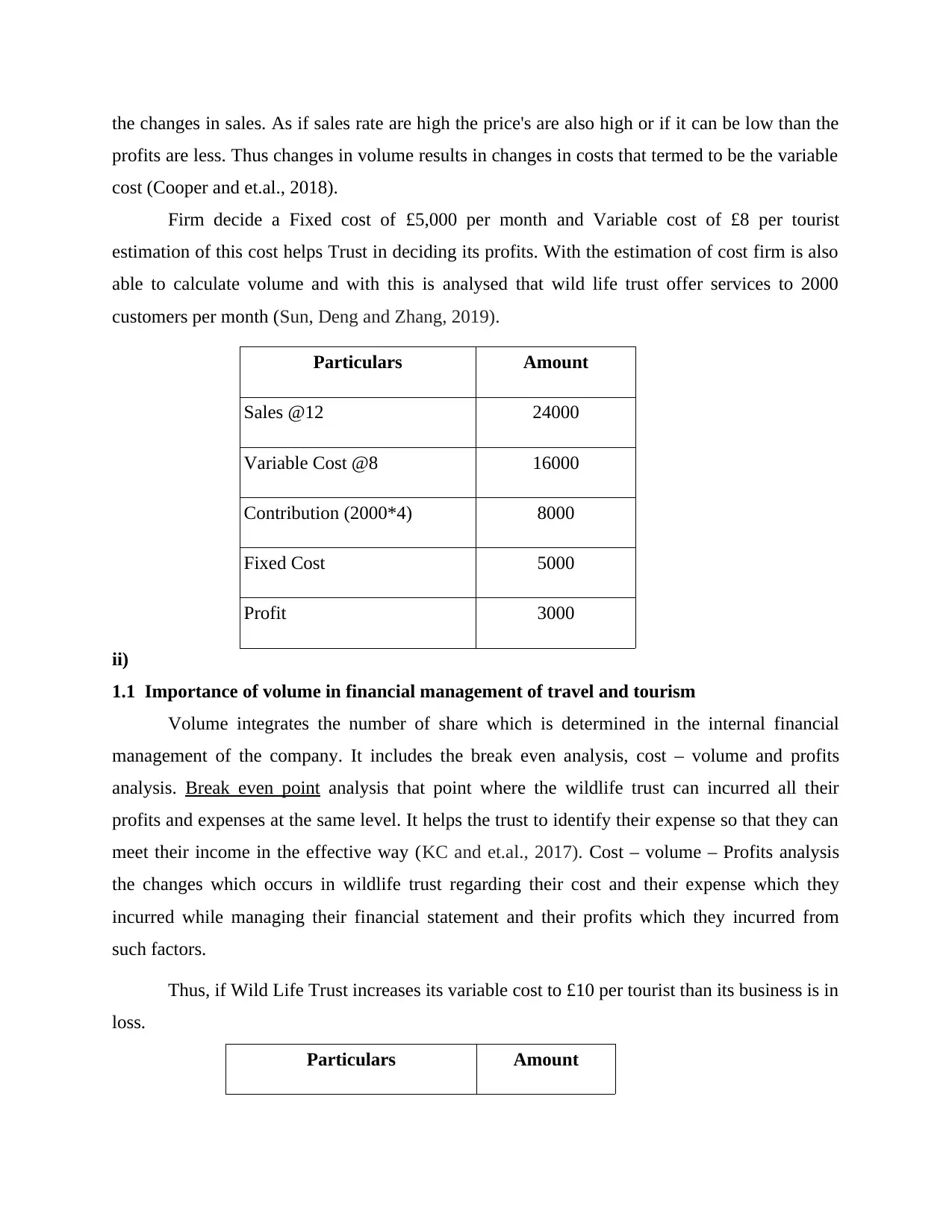
the changes in sales. As if sales rate are high the price's are also high or if it can be low than the
profits are less. Thus changes in volume results in changes in costs that termed to be the variable
cost (Cooper and et.al., 2018).
Firm decide a Fixed cost of £5,000 per month and Variable cost of £8 per tourist
estimation of this cost helps Trust in deciding its profits. With the estimation of cost firm is also
able to calculate volume and with this is analysed that wild life trust offer services to 2000
customers per month (Sun, Deng and Zhang, 2019).
Particulars Amount
Sales @12 24000
Variable Cost @8 16000
Contribution (2000*4) 8000
Fixed Cost 5000
Profit 3000
ii)
1.1 Importance of volume in financial management of travel and tourism
Volume integrates the number of share which is determined in the internal financial
management of the company. It includes the break even analysis, cost – volume and profits
analysis. Break even point analysis that point where the wildlife trust can incurred all their
profits and expenses at the same level. It helps the trust to identify their expense so that they can
meet their income in the effective way (KC and et.al., 2017). Cost – volume – Profits analysis
the changes which occurs in wildlife trust regarding their cost and their expense which they
incurred while managing their financial statement and their profits which they incurred from
such factors.
Thus, if Wild Life Trust increases its variable cost to £10 per tourist than its business is in
loss.
Particulars Amount
profits are less. Thus changes in volume results in changes in costs that termed to be the variable
cost (Cooper and et.al., 2018).
Firm decide a Fixed cost of £5,000 per month and Variable cost of £8 per tourist
estimation of this cost helps Trust in deciding its profits. With the estimation of cost firm is also
able to calculate volume and with this is analysed that wild life trust offer services to 2000
customers per month (Sun, Deng and Zhang, 2019).
Particulars Amount
Sales @12 24000
Variable Cost @8 16000
Contribution (2000*4) 8000
Fixed Cost 5000
Profit 3000
ii)
1.1 Importance of volume in financial management of travel and tourism
Volume integrates the number of share which is determined in the internal financial
management of the company. It includes the break even analysis, cost – volume and profits
analysis. Break even point analysis that point where the wildlife trust can incurred all their
profits and expenses at the same level. It helps the trust to identify their expense so that they can
meet their income in the effective way (KC and et.al., 2017). Cost – volume – Profits analysis
the changes which occurs in wildlife trust regarding their cost and their expense which they
incurred while managing their financial statement and their profits which they incurred from
such factors.
Thus, if Wild Life Trust increases its variable cost to £10 per tourist than its business is in
loss.
Particulars Amount
Paraphrase This Document
Need a fresh take? Get an instant paraphrase of this document with our AI Paraphraser
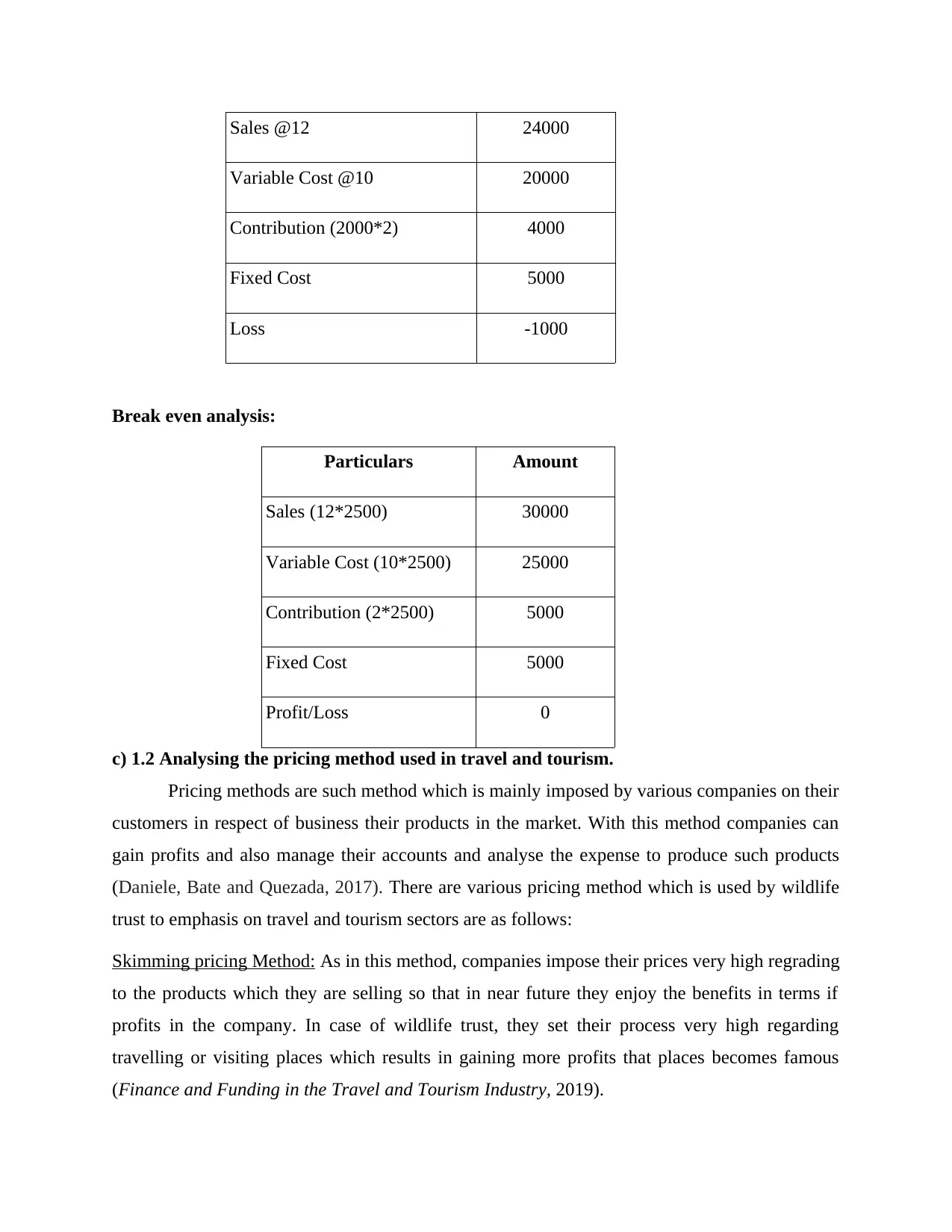
Sales @12 24000
Variable Cost @10 20000
Contribution (2000*2) 4000
Fixed Cost 5000
Loss -1000
Break even analysis:
Particulars Amount
Sales (12*2500) 30000
Variable Cost (10*2500) 25000
Contribution (2*2500) 5000
Fixed Cost 5000
Profit/Loss 0
c) 1.2 Analysing the pricing method used in travel and tourism.
Pricing methods are such method which is mainly imposed by various companies on their
customers in respect of business their products in the market. With this method companies can
gain profits and also manage their accounts and analyse the expense to produce such products
(Daniele, Bate and Quezada, 2017). There are various pricing method which is used by wildlife
trust to emphasis on travel and tourism sectors are as follows:
Skimming pricing Method: As in this method, companies impose their prices very high regrading
to the products which they are selling so that in near future they enjoy the benefits in terms if
profits in the company. In case of wildlife trust, they set their process very high regarding
travelling or visiting places which results in gaining more profits that places becomes famous
(Finance and Funding in the Travel and Tourism Industry, 2019).
Variable Cost @10 20000
Contribution (2000*2) 4000
Fixed Cost 5000
Loss -1000
Break even analysis:
Particulars Amount
Sales (12*2500) 30000
Variable Cost (10*2500) 25000
Contribution (2*2500) 5000
Fixed Cost 5000
Profit/Loss 0
c) 1.2 Analysing the pricing method used in travel and tourism.
Pricing methods are such method which is mainly imposed by various companies on their
customers in respect of business their products in the market. With this method companies can
gain profits and also manage their accounts and analyse the expense to produce such products
(Daniele, Bate and Quezada, 2017). There are various pricing method which is used by wildlife
trust to emphasis on travel and tourism sectors are as follows:
Skimming pricing Method: As in this method, companies impose their prices very high regrading
to the products which they are selling so that in near future they enjoy the benefits in terms if
profits in the company. In case of wildlife trust, they set their process very high regarding
travelling or visiting places which results in gaining more profits that places becomes famous
(Finance and Funding in the Travel and Tourism Industry, 2019).
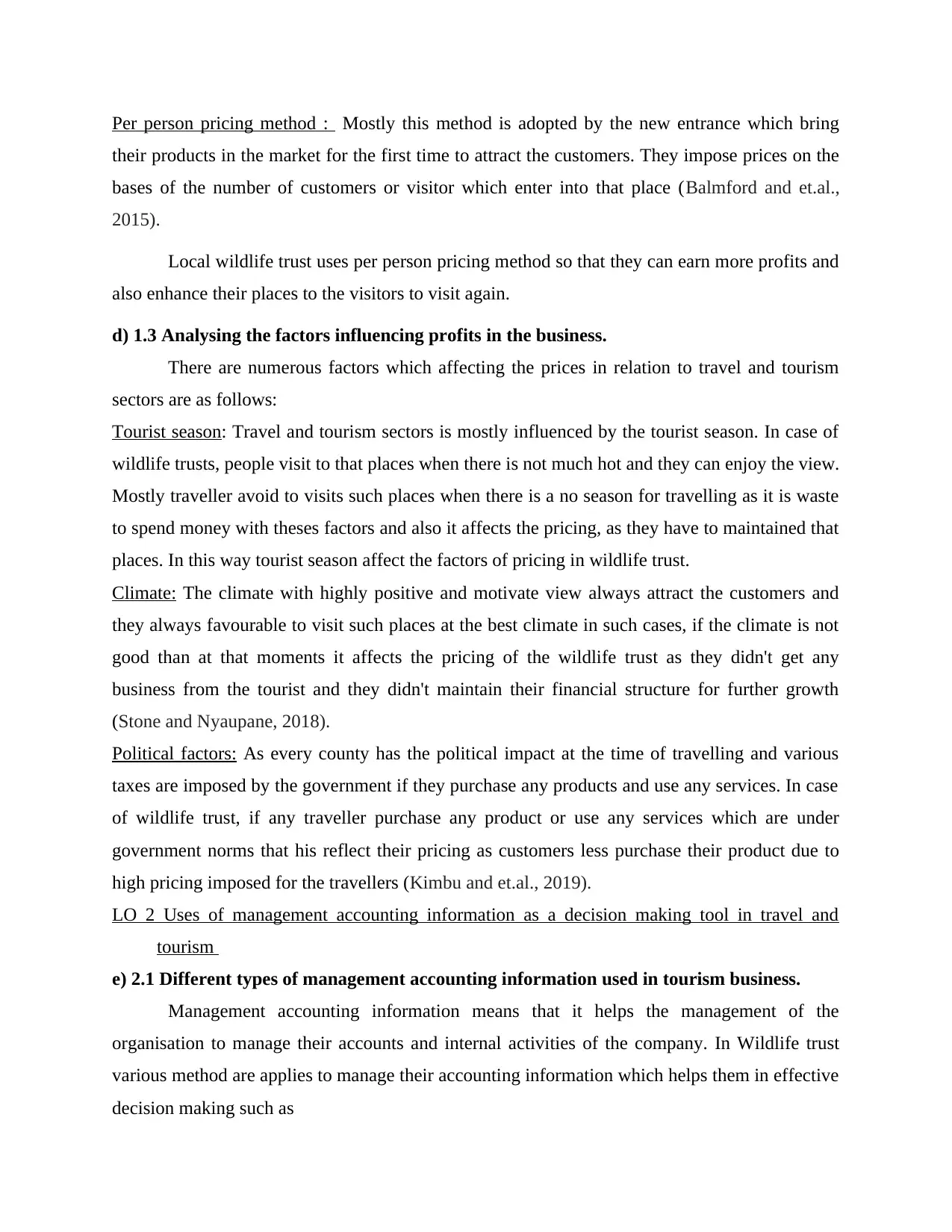
Per person pricing method : Mostly this method is adopted by the new entrance which bring
their products in the market for the first time to attract the customers. They impose prices on the
bases of the number of customers or visitor which enter into that place (Balmford and et.al.,
2015).
Local wildlife trust uses per person pricing method so that they can earn more profits and
also enhance their places to the visitors to visit again.
d) 1.3 Analysing the factors influencing profits in the business.
There are numerous factors which affecting the prices in relation to travel and tourism
sectors are as follows:
Tourist season: Travel and tourism sectors is mostly influenced by the tourist season. In case of
wildlife trusts, people visit to that places when there is not much hot and they can enjoy the view.
Mostly traveller avoid to visits such places when there is a no season for travelling as it is waste
to spend money with theses factors and also it affects the pricing, as they have to maintained that
places. In this way tourist season affect the factors of pricing in wildlife trust.
Climate: The climate with highly positive and motivate view always attract the customers and
they always favourable to visit such places at the best climate in such cases, if the climate is not
good than at that moments it affects the pricing of the wildlife trust as they didn't get any
business from the tourist and they didn't maintain their financial structure for further growth
(Stone and Nyaupane, 2018).
Political factors: As every county has the political impact at the time of travelling and various
taxes are imposed by the government if they purchase any products and use any services. In case
of wildlife trust, if any traveller purchase any product or use any services which are under
government norms that his reflect their pricing as customers less purchase their product due to
high pricing imposed for the travellers (Kimbu and et.al., 2019).
LO 2 Uses of management accounting information as a decision making tool in travel and
tourism
e) 2.1 Different types of management accounting information used in tourism business.
Management accounting information means that it helps the management of the
organisation to manage their accounts and internal activities of the company. In Wildlife trust
various method are applies to manage their accounting information which helps them in effective
decision making such as
their products in the market for the first time to attract the customers. They impose prices on the
bases of the number of customers or visitor which enter into that place (Balmford and et.al.,
2015).
Local wildlife trust uses per person pricing method so that they can earn more profits and
also enhance their places to the visitors to visit again.
d) 1.3 Analysing the factors influencing profits in the business.
There are numerous factors which affecting the prices in relation to travel and tourism
sectors are as follows:
Tourist season: Travel and tourism sectors is mostly influenced by the tourist season. In case of
wildlife trusts, people visit to that places when there is not much hot and they can enjoy the view.
Mostly traveller avoid to visits such places when there is a no season for travelling as it is waste
to spend money with theses factors and also it affects the pricing, as they have to maintained that
places. In this way tourist season affect the factors of pricing in wildlife trust.
Climate: The climate with highly positive and motivate view always attract the customers and
they always favourable to visit such places at the best climate in such cases, if the climate is not
good than at that moments it affects the pricing of the wildlife trust as they didn't get any
business from the tourist and they didn't maintain their financial structure for further growth
(Stone and Nyaupane, 2018).
Political factors: As every county has the political impact at the time of travelling and various
taxes are imposed by the government if they purchase any products and use any services. In case
of wildlife trust, if any traveller purchase any product or use any services which are under
government norms that his reflect their pricing as customers less purchase their product due to
high pricing imposed for the travellers (Kimbu and et.al., 2019).
LO 2 Uses of management accounting information as a decision making tool in travel and
tourism
e) 2.1 Different types of management accounting information used in tourism business.
Management accounting information means that it helps the management of the
organisation to manage their accounts and internal activities of the company. In Wildlife trust
various method are applies to manage their accounting information which helps them in effective
decision making such as
⊘ This is a preview!⊘
Do you want full access?
Subscribe today to unlock all pages.

Trusted by 1+ million students worldwide
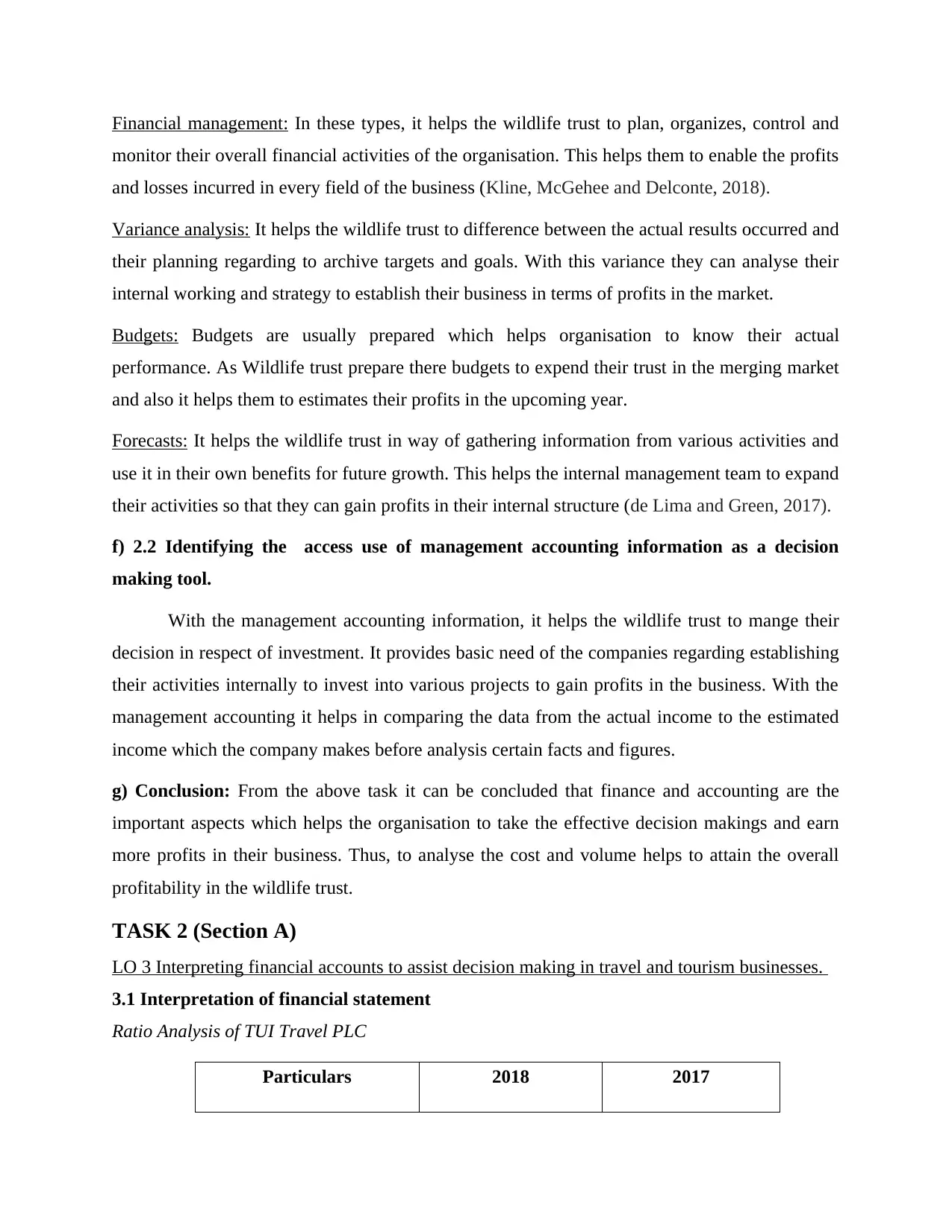
Financial management: In these types, it helps the wildlife trust to plan, organizes, control and
monitor their overall financial activities of the organisation. This helps them to enable the profits
and losses incurred in every field of the business (Kline, McGehee and Delconte, 2018).
Variance analysis: It helps the wildlife trust to difference between the actual results occurred and
their planning regarding to archive targets and goals. With this variance they can analyse their
internal working and strategy to establish their business in terms of profits in the market.
Budgets: Budgets are usually prepared which helps organisation to know their actual
performance. As Wildlife trust prepare there budgets to expend their trust in the merging market
and also it helps them to estimates their profits in the upcoming year.
Forecasts: It helps the wildlife trust in way of gathering information from various activities and
use it in their own benefits for future growth. This helps the internal management team to expand
their activities so that they can gain profits in their internal structure (de Lima and Green, 2017).
f) 2.2 Identifying the access use of management accounting information as a decision
making tool.
With the management accounting information, it helps the wildlife trust to mange their
decision in respect of investment. It provides basic need of the companies regarding establishing
their activities internally to invest into various projects to gain profits in the business. With the
management accounting it helps in comparing the data from the actual income to the estimated
income which the company makes before analysis certain facts and figures.
g) Conclusion: From the above task it can be concluded that finance and accounting are the
important aspects which helps the organisation to take the effective decision makings and earn
more profits in their business. Thus, to analyse the cost and volume helps to attain the overall
profitability in the wildlife trust.
TASK 2 (Section A)
LO 3 Interpreting financial accounts to assist decision making in travel and tourism businesses.
3.1 Interpretation of financial statement
Ratio Analysis of TUI Travel PLC
Particulars 2018 2017
monitor their overall financial activities of the organisation. This helps them to enable the profits
and losses incurred in every field of the business (Kline, McGehee and Delconte, 2018).
Variance analysis: It helps the wildlife trust to difference between the actual results occurred and
their planning regarding to archive targets and goals. With this variance they can analyse their
internal working and strategy to establish their business in terms of profits in the market.
Budgets: Budgets are usually prepared which helps organisation to know their actual
performance. As Wildlife trust prepare there budgets to expend their trust in the merging market
and also it helps them to estimates their profits in the upcoming year.
Forecasts: It helps the wildlife trust in way of gathering information from various activities and
use it in their own benefits for future growth. This helps the internal management team to expand
their activities so that they can gain profits in their internal structure (de Lima and Green, 2017).
f) 2.2 Identifying the access use of management accounting information as a decision
making tool.
With the management accounting information, it helps the wildlife trust to mange their
decision in respect of investment. It provides basic need of the companies regarding establishing
their activities internally to invest into various projects to gain profits in the business. With the
management accounting it helps in comparing the data from the actual income to the estimated
income which the company makes before analysis certain facts and figures.
g) Conclusion: From the above task it can be concluded that finance and accounting are the
important aspects which helps the organisation to take the effective decision makings and earn
more profits in their business. Thus, to analyse the cost and volume helps to attain the overall
profitability in the wildlife trust.
TASK 2 (Section A)
LO 3 Interpreting financial accounts to assist decision making in travel and tourism businesses.
3.1 Interpretation of financial statement
Ratio Analysis of TUI Travel PLC
Particulars 2018 2017
Paraphrase This Document
Need a fresh take? Get an instant paraphrase of this document with our AI Paraphraser
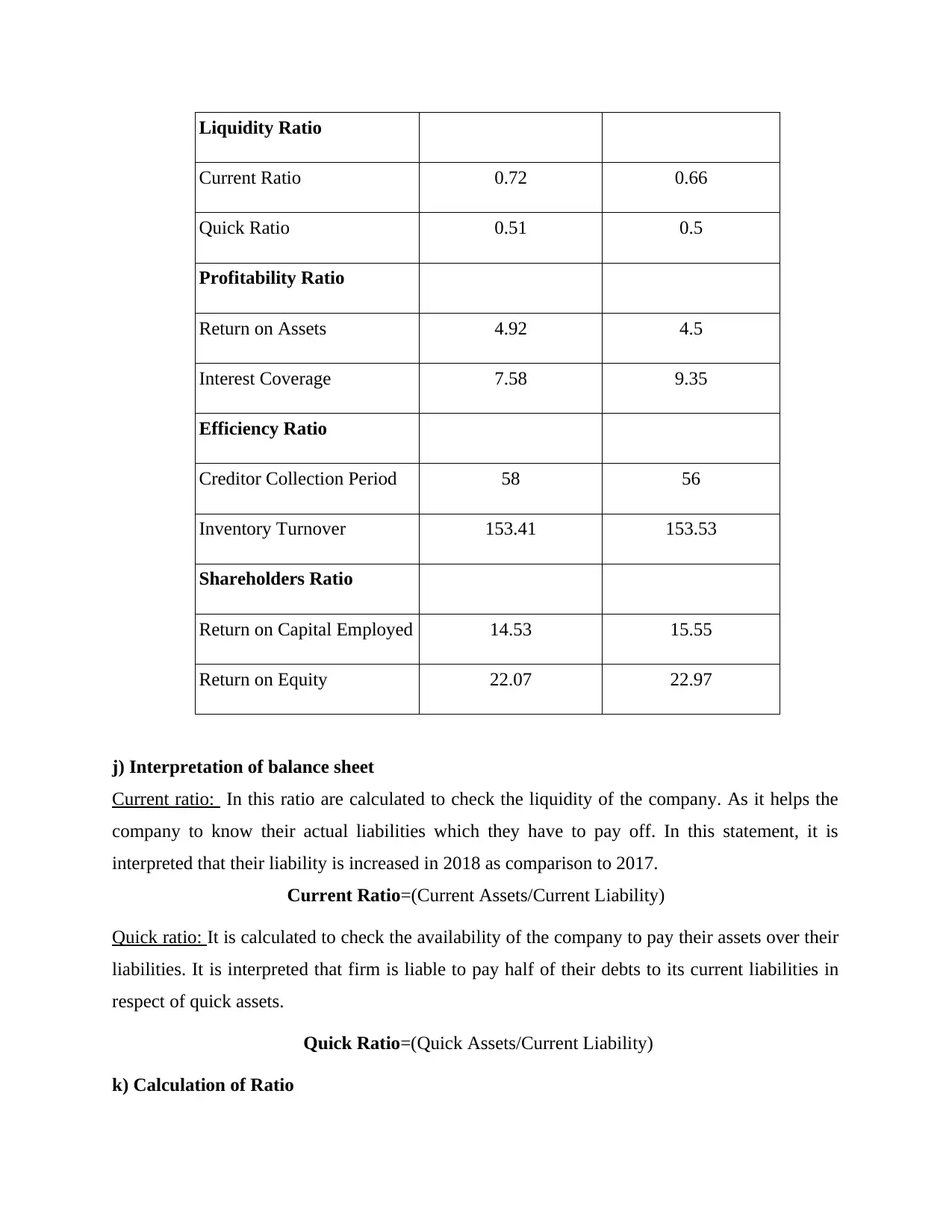
Liquidity Ratio
Current Ratio 0.72 0.66
Quick Ratio 0.51 0.5
Profitability Ratio
Return on Assets 4.92 4.5
Interest Coverage 7.58 9.35
Efficiency Ratio
Creditor Collection Period 58 56
Inventory Turnover 153.41 153.53
Shareholders Ratio
Return on Capital Employed 14.53 15.55
Return on Equity 22.07 22.97
j) Interpretation of balance sheet
Current ratio: In this ratio are calculated to check the liquidity of the company. As it helps the
company to know their actual liabilities which they have to pay off. In this statement, it is
interpreted that their liability is increased in 2018 as comparison to 2017.
Current Ratio=(Current Assets/Current Liability)
Quick ratio: It is calculated to check the availability of the company to pay their assets over their
liabilities. It is interpreted that firm is liable to pay half of their debts to its current liabilities in
respect of quick assets.
Quick Ratio=(Quick Assets/Current Liability)
k) Calculation of Ratio
Current Ratio 0.72 0.66
Quick Ratio 0.51 0.5
Profitability Ratio
Return on Assets 4.92 4.5
Interest Coverage 7.58 9.35
Efficiency Ratio
Creditor Collection Period 58 56
Inventory Turnover 153.41 153.53
Shareholders Ratio
Return on Capital Employed 14.53 15.55
Return on Equity 22.07 22.97
j) Interpretation of balance sheet
Current ratio: In this ratio are calculated to check the liquidity of the company. As it helps the
company to know their actual liabilities which they have to pay off. In this statement, it is
interpreted that their liability is increased in 2018 as comparison to 2017.
Current Ratio=(Current Assets/Current Liability)
Quick ratio: It is calculated to check the availability of the company to pay their assets over their
liabilities. It is interpreted that firm is liable to pay half of their debts to its current liabilities in
respect of quick assets.
Quick Ratio=(Quick Assets/Current Liability)
k) Calculation of Ratio
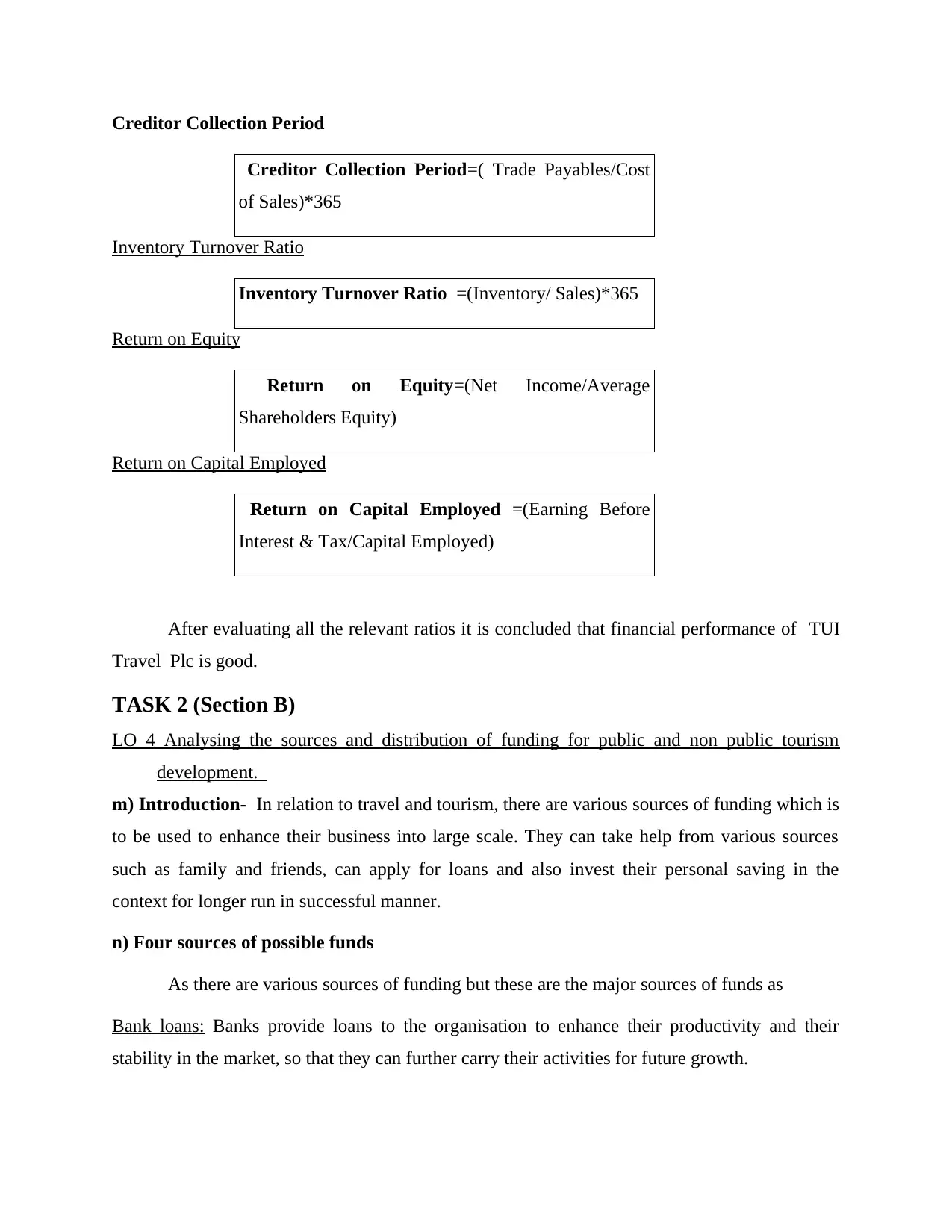
Creditor Collection Period
Creditor Collection Period=( Trade Payables/Cost
of Sales)*365
Inventory Turnover Ratio
Inventory Turnover Ratio =(Inventory/ Sales)*365
Return on Equity
Return on Equity=(Net Income/Average
Shareholders Equity)
Return on Capital Employed
Return on Capital Employed =(Earning Before
Interest & Tax/Capital Employed)
After evaluating all the relevant ratios it is concluded that financial performance of TUI
Travel Plc is good.
TASK 2 (Section B)
LO 4 Analysing the sources and distribution of funding for public and non public tourism
development.
m) Introduction- In relation to travel and tourism, there are various sources of funding which is
to be used to enhance their business into large scale. They can take help from various sources
such as family and friends, can apply for loans and also invest their personal saving in the
context for longer run in successful manner.
n) Four sources of possible funds
As there are various sources of funding but these are the major sources of funds as
Bank loans: Banks provide loans to the organisation to enhance their productivity and their
stability in the market, so that they can further carry their activities for future growth.
Creditor Collection Period=( Trade Payables/Cost
of Sales)*365
Inventory Turnover Ratio
Inventory Turnover Ratio =(Inventory/ Sales)*365
Return on Equity
Return on Equity=(Net Income/Average
Shareholders Equity)
Return on Capital Employed
Return on Capital Employed =(Earning Before
Interest & Tax/Capital Employed)
After evaluating all the relevant ratios it is concluded that financial performance of TUI
Travel Plc is good.
TASK 2 (Section B)
LO 4 Analysing the sources and distribution of funding for public and non public tourism
development.
m) Introduction- In relation to travel and tourism, there are various sources of funding which is
to be used to enhance their business into large scale. They can take help from various sources
such as family and friends, can apply for loans and also invest their personal saving in the
context for longer run in successful manner.
n) Four sources of possible funds
As there are various sources of funding but these are the major sources of funds as
Bank loans: Banks provide loans to the organisation to enhance their productivity and their
stability in the market, so that they can further carry their activities for future growth.
⊘ This is a preview!⊘
Do you want full access?
Subscribe today to unlock all pages.

Trusted by 1+ million students worldwide
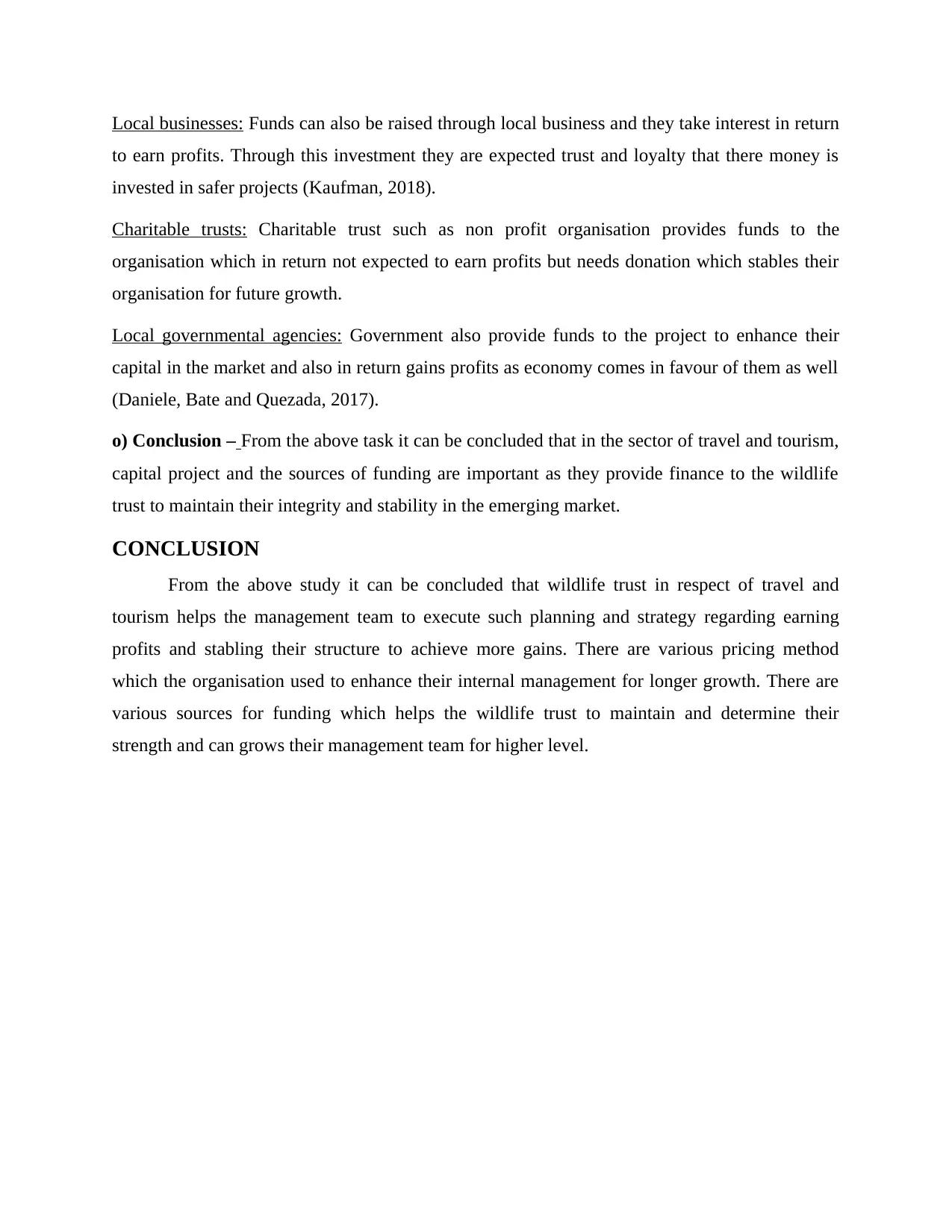
Local businesses: Funds can also be raised through local business and they take interest in return
to earn profits. Through this investment they are expected trust and loyalty that there money is
invested in safer projects (Kaufman, 2018).
Charitable trusts: Charitable trust such as non profit organisation provides funds to the
organisation which in return not expected to earn profits but needs donation which stables their
organisation for future growth.
Local governmental agencies: Government also provide funds to the project to enhance their
capital in the market and also in return gains profits as economy comes in favour of them as well
(Daniele, Bate and Quezada, 2017).
o) Conclusion – From the above task it can be concluded that in the sector of travel and tourism,
capital project and the sources of funding are important as they provide finance to the wildlife
trust to maintain their integrity and stability in the emerging market.
CONCLUSION
From the above study it can be concluded that wildlife trust in respect of travel and
tourism helps the management team to execute such planning and strategy regarding earning
profits and stabling their structure to achieve more gains. There are various pricing method
which the organisation used to enhance their internal management for longer growth. There are
various sources for funding which helps the wildlife trust to maintain and determine their
strength and can grows their management team for higher level.
to earn profits. Through this investment they are expected trust and loyalty that there money is
invested in safer projects (Kaufman, 2018).
Charitable trusts: Charitable trust such as non profit organisation provides funds to the
organisation which in return not expected to earn profits but needs donation which stables their
organisation for future growth.
Local governmental agencies: Government also provide funds to the project to enhance their
capital in the market and also in return gains profits as economy comes in favour of them as well
(Daniele, Bate and Quezada, 2017).
o) Conclusion – From the above task it can be concluded that in the sector of travel and tourism,
capital project and the sources of funding are important as they provide finance to the wildlife
trust to maintain their integrity and stability in the emerging market.
CONCLUSION
From the above study it can be concluded that wildlife trust in respect of travel and
tourism helps the management team to execute such planning and strategy regarding earning
profits and stabling their structure to achieve more gains. There are various pricing method
which the organisation used to enhance their internal management for longer growth. There are
various sources for funding which helps the wildlife trust to maintain and determine their
strength and can grows their management team for higher level.
Paraphrase This Document
Need a fresh take? Get an instant paraphrase of this document with our AI Paraphraser
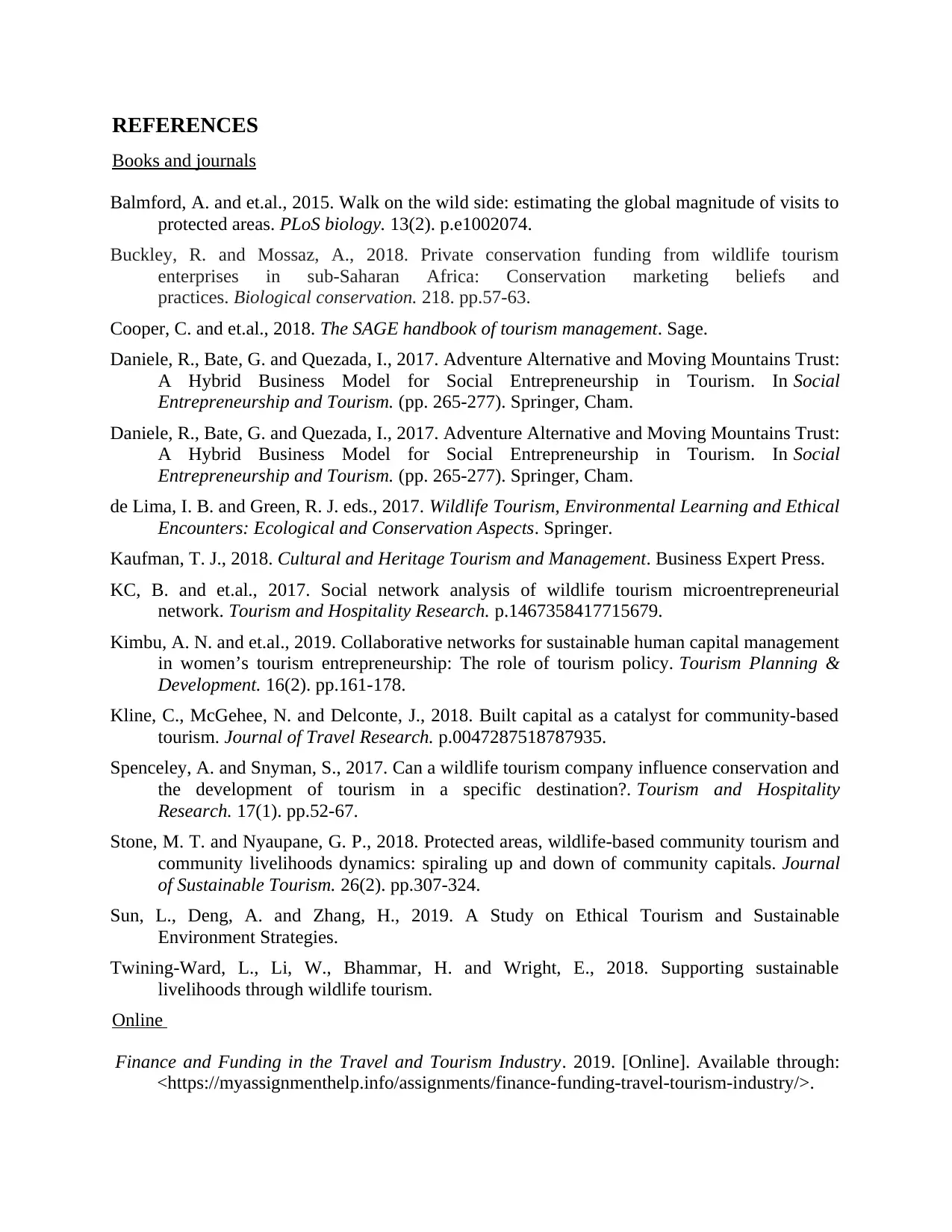
REFERENCES
Books and journals
Balmford, A. and et.al., 2015. Walk on the wild side: estimating the global magnitude of visits to
protected areas. PLoS biology. 13(2). p.e1002074.
Buckley, R. and Mossaz, A., 2018. Private conservation funding from wildlife tourism
enterprises in sub-Saharan Africa: Conservation marketing beliefs and
practices. Biological conservation. 218. pp.57-63.
Cooper, C. and et.al., 2018. The SAGE handbook of tourism management. Sage.
Daniele, R., Bate, G. and Quezada, I., 2017. Adventure Alternative and Moving Mountains Trust:
A Hybrid Business Model for Social Entrepreneurship in Tourism. In Social
Entrepreneurship and Tourism. (pp. 265-277). Springer, Cham.
Daniele, R., Bate, G. and Quezada, I., 2017. Adventure Alternative and Moving Mountains Trust:
A Hybrid Business Model for Social Entrepreneurship in Tourism. In Social
Entrepreneurship and Tourism. (pp. 265-277). Springer, Cham.
de Lima, I. B. and Green, R. J. eds., 2017. Wildlife Tourism, Environmental Learning and Ethical
Encounters: Ecological and Conservation Aspects. Springer.
Kaufman, T. J., 2018. Cultural and Heritage Tourism and Management. Business Expert Press.
KC, B. and et.al., 2017. Social network analysis of wildlife tourism microentrepreneurial
network. Tourism and Hospitality Research. p.1467358417715679.
Kimbu, A. N. and et.al., 2019. Collaborative networks for sustainable human capital management
in women’s tourism entrepreneurship: The role of tourism policy. Tourism Planning &
Development. 16(2). pp.161-178.
Kline, C., McGehee, N. and Delconte, J., 2018. Built capital as a catalyst for community-based
tourism. Journal of Travel Research. p.0047287518787935.
Spenceley, A. and Snyman, S., 2017. Can a wildlife tourism company influence conservation and
the development of tourism in a specific destination?. Tourism and Hospitality
Research. 17(1). pp.52-67.
Stone, M. T. and Nyaupane, G. P., 2018. Protected areas, wildlife-based community tourism and
community livelihoods dynamics: spiraling up and down of community capitals. Journal
of Sustainable Tourism. 26(2). pp.307-324.
Sun, L., Deng, A. and Zhang, H., 2019. A Study on Ethical Tourism and Sustainable
Environment Strategies.
Twining-Ward, L., Li, W., Bhammar, H. and Wright, E., 2018. Supporting sustainable
livelihoods through wildlife tourism.
Online
Finance and Funding in the Travel and Tourism Industry. 2019. [Online]. Available through:
<https://myassignmenthelp.info/assignments/finance-funding-travel-tourism-industry/>.
Books and journals
Balmford, A. and et.al., 2015. Walk on the wild side: estimating the global magnitude of visits to
protected areas. PLoS biology. 13(2). p.e1002074.
Buckley, R. and Mossaz, A., 2018. Private conservation funding from wildlife tourism
enterprises in sub-Saharan Africa: Conservation marketing beliefs and
practices. Biological conservation. 218. pp.57-63.
Cooper, C. and et.al., 2018. The SAGE handbook of tourism management. Sage.
Daniele, R., Bate, G. and Quezada, I., 2017. Adventure Alternative and Moving Mountains Trust:
A Hybrid Business Model for Social Entrepreneurship in Tourism. In Social
Entrepreneurship and Tourism. (pp. 265-277). Springer, Cham.
Daniele, R., Bate, G. and Quezada, I., 2017. Adventure Alternative and Moving Mountains Trust:
A Hybrid Business Model for Social Entrepreneurship in Tourism. In Social
Entrepreneurship and Tourism. (pp. 265-277). Springer, Cham.
de Lima, I. B. and Green, R. J. eds., 2017. Wildlife Tourism, Environmental Learning and Ethical
Encounters: Ecological and Conservation Aspects. Springer.
Kaufman, T. J., 2018. Cultural and Heritage Tourism and Management. Business Expert Press.
KC, B. and et.al., 2017. Social network analysis of wildlife tourism microentrepreneurial
network. Tourism and Hospitality Research. p.1467358417715679.
Kimbu, A. N. and et.al., 2019. Collaborative networks for sustainable human capital management
in women’s tourism entrepreneurship: The role of tourism policy. Tourism Planning &
Development. 16(2). pp.161-178.
Kline, C., McGehee, N. and Delconte, J., 2018. Built capital as a catalyst for community-based
tourism. Journal of Travel Research. p.0047287518787935.
Spenceley, A. and Snyman, S., 2017. Can a wildlife tourism company influence conservation and
the development of tourism in a specific destination?. Tourism and Hospitality
Research. 17(1). pp.52-67.
Stone, M. T. and Nyaupane, G. P., 2018. Protected areas, wildlife-based community tourism and
community livelihoods dynamics: spiraling up and down of community capitals. Journal
of Sustainable Tourism. 26(2). pp.307-324.
Sun, L., Deng, A. and Zhang, H., 2019. A Study on Ethical Tourism and Sustainable
Environment Strategies.
Twining-Ward, L., Li, W., Bhammar, H. and Wright, E., 2018. Supporting sustainable
livelihoods through wildlife tourism.
Online
Finance and Funding in the Travel and Tourism Industry. 2019. [Online]. Available through:
<https://myassignmenthelp.info/assignments/finance-funding-travel-tourism-industry/>.
1 out of 11
Related Documents
Your All-in-One AI-Powered Toolkit for Academic Success.
+13062052269
info@desklib.com
Available 24*7 on WhatsApp / Email
![[object Object]](/_next/static/media/star-bottom.7253800d.svg)
Unlock your academic potential
Copyright © 2020–2025 A2Z Services. All Rights Reserved. Developed and managed by ZUCOL.





